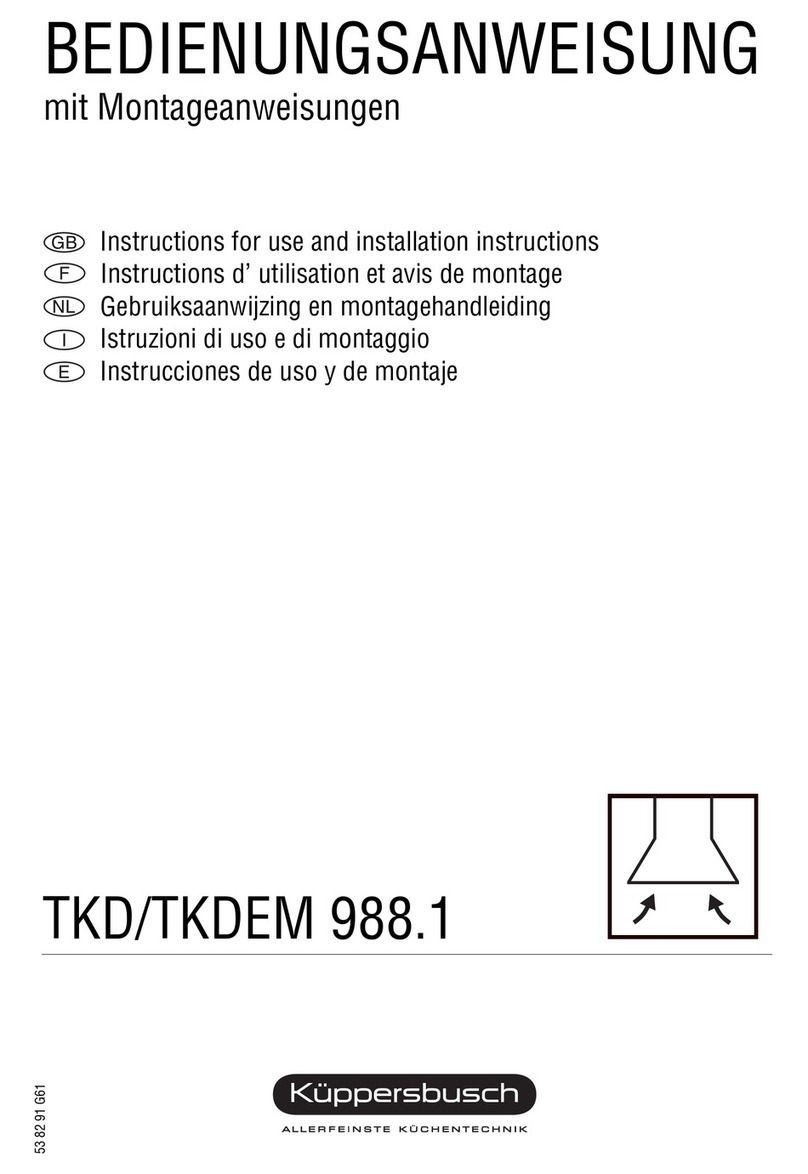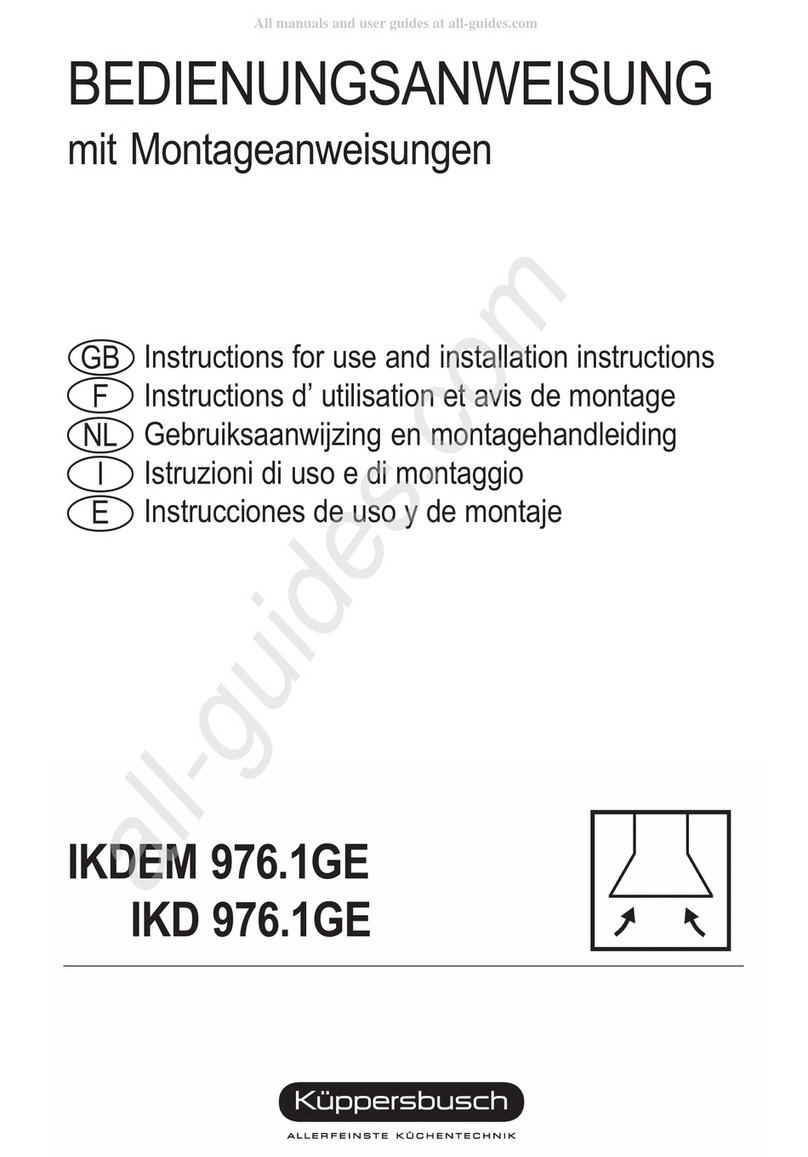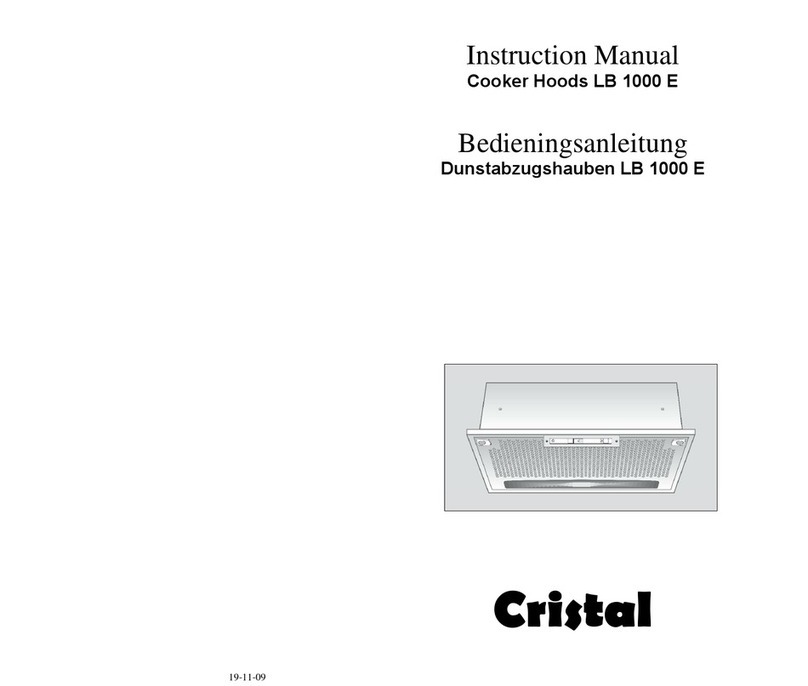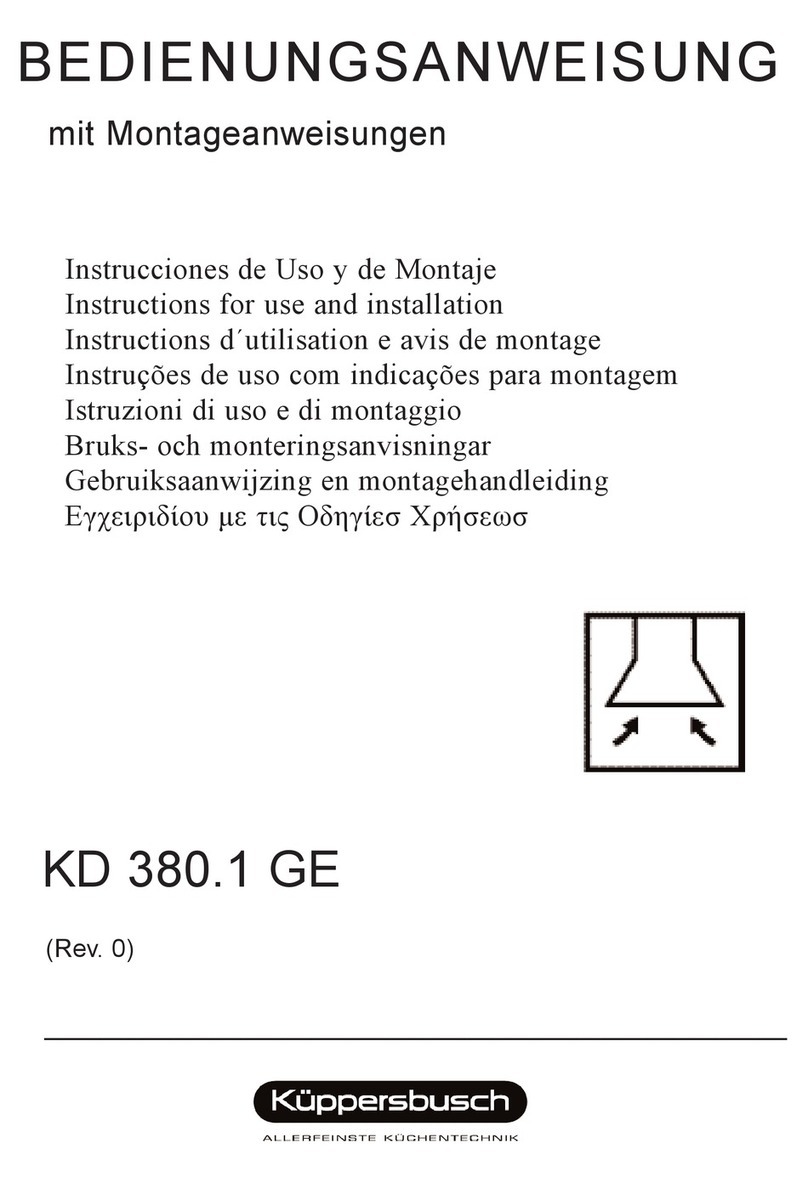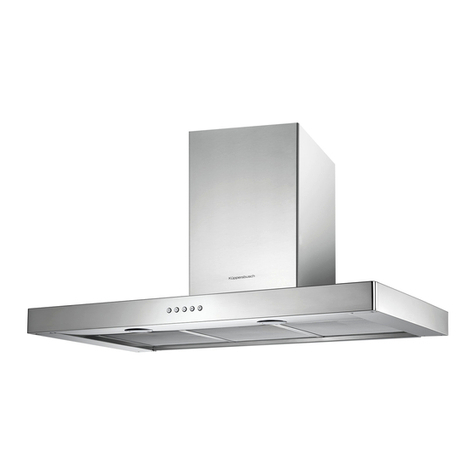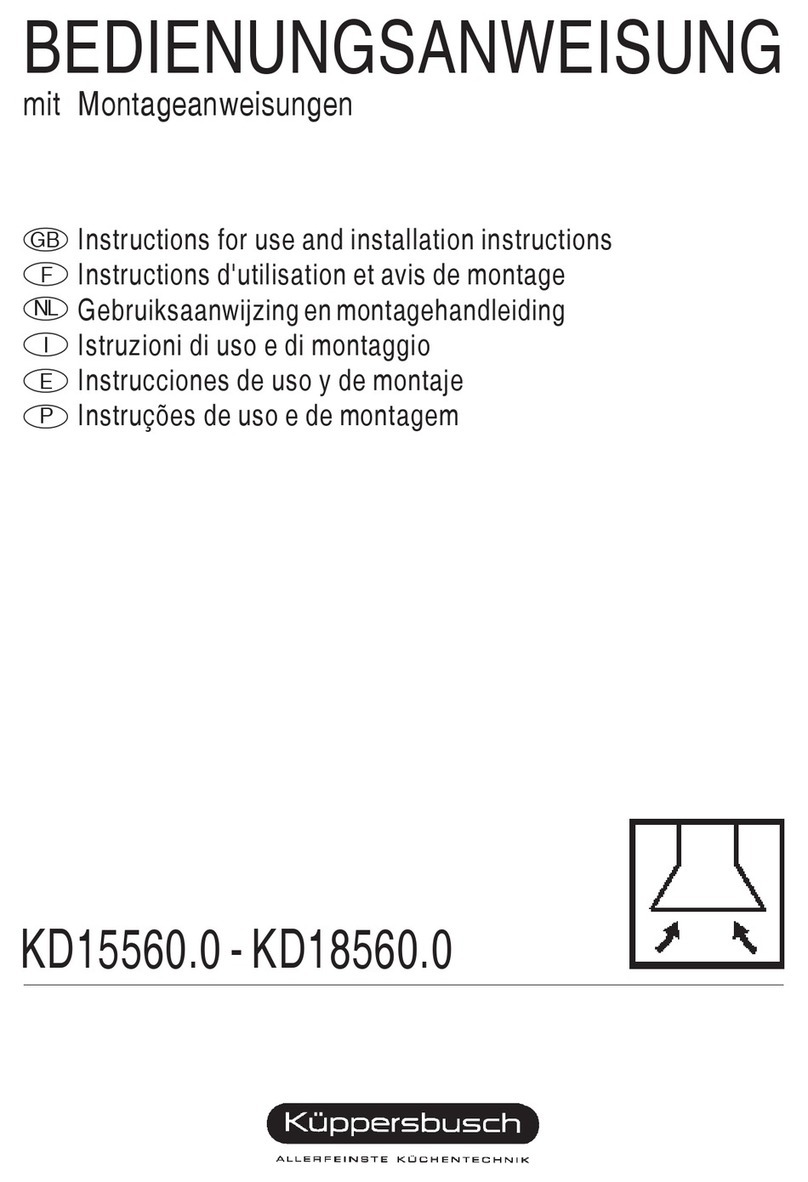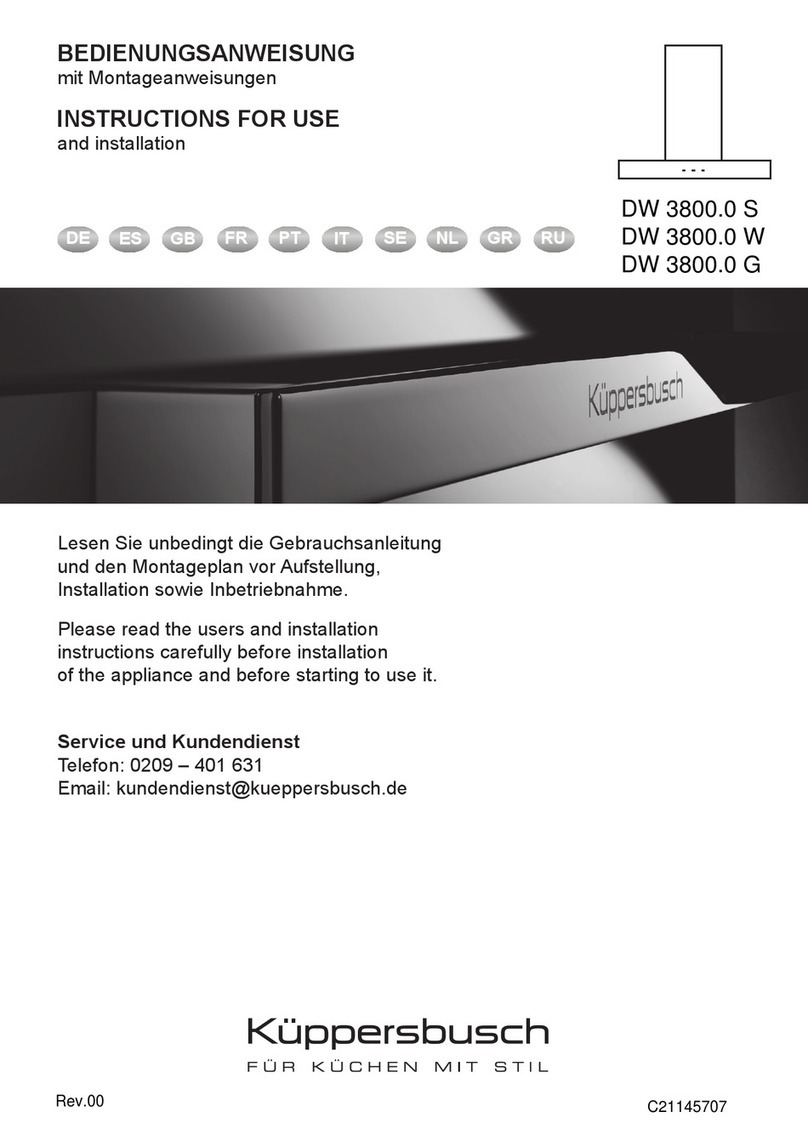zeigen an, dass die Fettfilter gereinigt werden
nüssen. Sind einmal die gereinigten Filter
wieder eingefügt, so drückt man auf irgend eine
der drei Betriebstasten, um den Timer wieder
einzusetzen.
Wechsel der Kohlefilter (bei Umluftgeräten):
Soweit das Gerät im Umluftbetrieb eingesetzt
wird, sind die Kohlefilter regelmäßig auszu-
tauschen und durch neue zu ersetzen. Die
Austauschhäufigkeit hängt auch hier ab von
der Benutzungsdauer und der Art der abzusau-
genden Wrasen. Mindestens sind die Kohlefilter
alle sechs Monate zu wechseln. Die Kohlefilter
sind am Motorgehäuse befestigt und können
durch Drehung gelöst und in umgekehrter
Drehrichtung befestigt werden (Abb. 13).
Um den/die Fettfilter abnehmen zu können,
muß zunächst das Filtergitter geöffnet werden.
Dies geschieht durch Drehung der beiden
Halterungen nach außen (Abb. 14). Dann ist
die Entfernung der Filter durch seitliches
Herausziehen nach rechts möglich (Abb. 15).
Wechsel der Halogenlampen
Beim Lampenwechsel ist zu beachten daß nach
längerem Betrieb des Gerätes die Lampen sehr
heiß werden. Es empfiehlt sich daher die Lam-
pen in abgekühltem Zustand zu wechseln. Die
Halogenlampen nie mit bloßen Fingern anfas-
sen! Zunächst ist die Lichtabdeckung zu öffnen
(Abb. 16). Nun kann die Halogenlampe gewe-
chselt werden. Im Austauschfall sind unbedingt
Halogenlampen des selben Typs zu
verwenden.
WARNING
--------------------------------------------------
The distance between the supporting
surface for the cooking vessels on the hob
and the lower part of the hood must be at
least 65 cm. If the instructions for installation
for the hob specify a greater distance, this
has to be taken into account.
The air collected must not be conveyed
into a duct used to blow off smokes from
appliances fed with an energy other than
electricity (central heating systems, ther-
mosiphons, water-heaters, etc.).
Comply with the official instructions provided
by the competent authorities in merit when
installing the disposal duct. In addition,
exhaust air should not be discharged into
a wall cavity, unless the cavity is designed
for that purpose.
The room must be well aerated in case a
hood and some other heat equipment fed
with an energy other than electricity (gas,
oil, coal heaters, etc) operate at the same
time. In fact the intake hood, disposing of
air, could create a vacuum in the room.
The vacuum should not exceed 0,04mbar.
This prevents the gas exhausted by the
heat source from being intaken again. It is
therefore advisable to ensure the room
contains air taps able to ensure a steady
flow of fresh air.
ATTENTION: This appliance must be
grounded.
The following warning is valid in the United
Kingdom only: in case your cable is not
furnished with a plug, read the following
instructions; as the colours of the wires in
the mains lead of this appliance may not
correspond with the coloured markings
identifying the terminals in your plug,
proceed as follows:
– the wire which is coloured green and
yellow must be connected to the terminal
in the plug which is marked with the letter
E or by the earth symbol [ ], or coloured
green or green and yellow;
– the wire which is coloured blue must be
connected to the terminal which is marked
with the letter N or coloured black;
English
– the wire which is coloured brown must
be connected to the terminal which is
marked with the letter L or coloured red.
When making the electrical connections,
check that the current socket has a ground
connection and that the voltage values
correspond to those indicated on the data
plate inside the appliance itself.
In case your appliance is not furnished with
a non separating flexible cable and has no
plug, or has not got any other device ensu-
ring omnipolar disconnection from the elec-
tricity main, with a contact opening distance
of at least 3 mm, such separating device
ensuring disconnection from the main must
be included in the fixed installation. If your
unit features a power lead and plug, position
this so the plug is accessible.
Always switch off the electricity supply be-
fore carrying out any cleaning or servicing
operations on the appliance.
USE
--------------------------------------------------
Avoid using materials which could cause
spurts of flame (flambées) near the ap-
pliance.
When frying, take particular care to prevent
oil and grease from catching fire. Already
used oil is especially dangerous in this re-
spect. Do not use uncovered electric grates.
To avoid possible risks of fire always
comply with the indicated instructions when
cleaning grease filters and when removing
grease deposits from the appliance.
MAINTENANCE
--------------------------------------------------
Thorough servicing guarantees correct and
long-lasting operation.
Particular care must be paid to the anti-
grease filters which must be periodically
cleaned in relation to use (at least once
every two months). Remove the grease
filters and wash them either using neutral
detergent.
Any fat deposits should be removed from
the appliance periodically depending on
amount of use (at least every 2 months).
Avoid using abrasive or corrosive products.
To clean painted appliances on the outside,
use a cloth dipped in lukewarm water and
neutral detergent. To clean steel, copper
or brass appliances on the outside, it is
always best to use specific products,
following the instructions on the products
themselves. To clean the inside of the
appliance, use a cloth (or brush) dipped in
denatured ethyl alcohol.
DESCRIPTION
--------------------------------------------------
The appliance can be a filtering version one, a
ducting version one or with an external motor.
In the Filtering version (Fig. 1), the air and
vapours conveyed by the appliance are depu-
rated by charcoal filters and recirculated around
the room.
ATTENTION: When using the filtering version,
two charcoal filters must be installed.
In the Ducting version (Fig. 2), cooking va-
pours and odours are conveyed straight out-
side by a disposal duct which passes through
the wall/ceiling. Use of charcoal filters is there-
fore unnecessary.
In the version with an External motor (Fig. 3),
the appliance must be connected to an ducting
apparatus/motor which works on its own using
the appliance as a union for the air to be scav-
enged. Use only motors "Küppersbusch".
INSTALLATION
--------------------------------------------------
The following operations are essential for as-
sembly:
– Cut a hole in the bottom of the pensile
cupboard in order to settle the appliance
(Fig. 4).
– Install the wiring system.
– Prepare the air venting hole if your appli-
ance is to be installed in the ducting ver-
sion or in the version with an external motor.
Fix the air venting flange onto the apparatus;
according to the version you bought, it must
be fixed either by means of screws (as in Fig.
5 and 6) o pressing slightly (see Fig. 7).
To install the appliance, adjust the position of
the clasping side spring by means of the proper
screws (Fig. 8), according to the thickness of
the bored panel to which it is going to be an-
chored. Insert the appliance in the pensile cup-
board and lock it by means of the side spring.
Use the holes which have already been made
in the casing of the appliance to definitively fix


